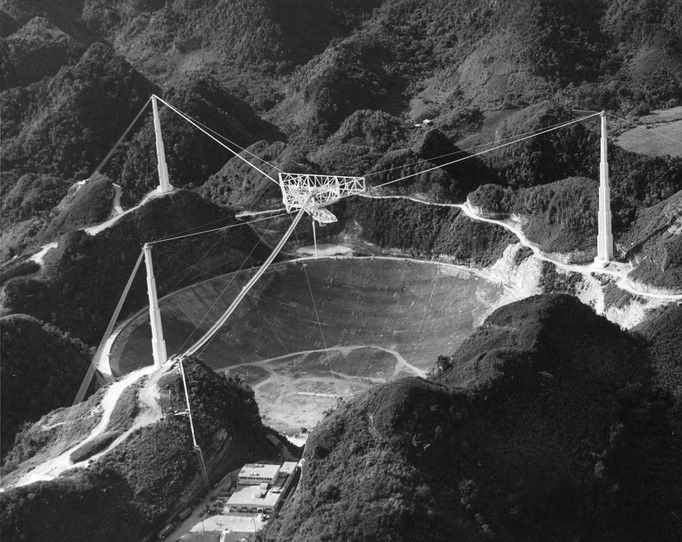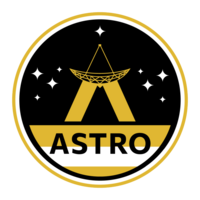THE RISE AND FALL OF THE ARECIBO OBSERVATORY
AUGUST 1st 2024 | Panagiota Isaak
“Nothing gold can stay.”
–Robert Frost
Introduction
For over half a century, the Arecibo Observatory in Puerto Rico stood as a beacon of human ingenuity and our relentless quest to understand the universe. With its impressive 305-meter diameter reflector, Arecibo reigned for decades as the world's largest single-aperture telescope, leaving an indelible mark on science and culture [1, 4].
In the late 1950s, William Edwin Gordon, a professor of electrical engineering at Cornell University, conceived the idea of a giant radio telescope. His inspiration came from his military service and interest in meteorology. Gordon envisioned a tool that could study the ionosphere in depth, the upper layer of Earth's atmosphere ionized by solar and cosmic radiation.
To overcome the challenges of studying this hard-to-reach layer, Gordon proposed using the ISR (Incoherent Scatter Radar) technique. This method involves sending powerful radio waves into the ionosphere and analyzing the weak echoes scattered back by free electrons. By analyzing the spectrum of scattered waves, scientists could extract valuable information about the temperature and density of ionospheric electrons.
Gordon's vision led to a truly innovative design: a fixed spherical reflector placed in a natural cavity, with a movable antenna structure suspended 150 meters above it. This unique approach would allow not only unprecedented observations of the ionosphere but would also open new horizons for studying distant celestial bodies and phenomena beyond Earth [1, 2].


The accurate determination of Mercury's rotation period (1964): Using its radar system, Arecibo revealed that Mercury's rotation period was about 59 days, not 88 as previously believed [4, 5].
The discovery of the first binary pulsar (1974): This discovery by Russell Hulse and Joseph Taylor Jr. led to the 1993 Nobel Prize in Physics, as it provided the first indirect evidence of gravitational waves [4, 5].
The "Arecibo Message" (1974): Arecibo made history by sending the first intentional radio message to potential extraterrestrial civilizations. The message, a binary-encoded 1,679-bit signal, was sent towards the globular cluster M13, located about 25,000 light-years away [4, 5].

The detection of the first exoplanet around a pulsar (1992): Arecibo, with its exceptional sensitivity, managed to detect small periodic fluctuations in the timing of pulsar PSR B1257+12's pulses, indicating the presence of planets orbiting it. This discovery opened a new chapter in astronomy, as it was the first confirmed detection of planets outside our solar system [4, 5].
The detection of the first repeating fast radio burst (2016): These signals last a few milliseconds to a few tens of milliseconds and have an extragalactic origin. The fact that it is repeating indicates that its source survives the energetic events that cause the flashes, ruling out a category of models that require these to be catastrophic [5].
To remain at the forefront of scientific research, Arecibo underwent two major upgrades:
1974: A new reflector surface dramatically improved the accuracy of observations [1, 4].
1997: The addition of a Gregorian dome significantly increased the telescope's sensitivity and frequency range [1, 4].
These upgrades not only improved sensitivity but also extended the frequency range, allowing observations from about 50 MHz to 10 GHz. This significantly broadened Arecibo's scientific capabilities, enabling it to remain competitive and continue producing groundbreaking research for decades [1, 4].
Arecibo was the largest radio telescope until the creation of FAST (Five-hundred-meter Aperture Spherical Telescope) in China in 2016. Despite its undeniable success, this promising giant had an unpredictable and tragic history:
August 2020: An auxiliary cable detached from a radio telescope tower, causing the first serious damage to the reflector [3, 5].
November 2020: A main support cable broke, jeopardizing the possibility of safely restoring the telescope [3, 5].
December 2020: The 900-ton central platform collapsed, destroying the reflector and marking the definitive end of the historic telescope's operation [3, 5].
The underlying cause of this catastrophic sequence of events was likely metal fatigue and corrosion of the support cables, exacerbated by the harsh tropical environment. The collapse of Arecibo shocked the scientific community and the general public [3, 5].
Despite its tragic end, Arecibo's legacy remains unaltered. Its contribution to astronomy, planetary science, and atmospheric physics is invaluable. As a tribute, an asteroid was named 4337 Arecibo, perpetuating its memory in the universe it so tirelessly studied [4, 5].
Although the U.S. National Science Foundation (NSF) decided not to rebuild the telescope, it is considering proposals to transform the site into a cutting-edge educational center. This initiative aims to inspire the next generation of scientists and engineers, keeping alive the spirit of exploration that Arecibo embodied [3, 5].
Moreover, other observatory facilities, such as the LIDAR system and a smaller radio telescope, remain operational, continuing scientific work in the area.

The Arecibo Observatory remains an eternal symbol of human curiosity, scientific innovation, and the relentless pursuit of knowledge. Its story reminds us of the importance of continuous investment in scientific research and infrastructure, as well as the need to keep alive the passion for exploring and understanding the universe that surrounds us [1-5].
As we look to the future, the spirit of Arecibo continues to inspire scientists, engineers, and dreamers around the world, reminding us that the greatest discoveries may lie just beyond the horizon, awaiting those who dare to look beyond the limits of the known.
EXOPLANET: A planet that orbits a star outside our solar system.
INCOHERENT SCATTER RADAR (ISR): A technique that uses powerful radio waves to study the Earth's upper atmosphere.
IONOSPHERE: The upper layer of Earth's atmosphere that is ionized by solar and cosmic radiation.
PLANETARY SCIENCE: The scientific study of planets, moons, and planetary systems.
PULSAR: A highly magnetized, rotating neutron star that emits beams of electromagnetic radiation.
RADIO ASTRONOMY: A subfield of astronomy that studies celestial objects at radio frequencies.
RADIO TELESCOPE: An astronomical instrument consisting of a radio receiver and an antenna system that is used to detect radio-frequency radiation emitted by extraterrestrial sources.
RADIO WAVES: Electromagnetic waves with wavelengths longer than infrared light.
FAST RADIO BURST (FRB): Intense, brief bursts of radio emission from deep space, lasting only milliseconds.
SPHERICAL REFLECTOR: The main collecting dish of the Arecibo telescope, shaped like part of a sphere.
GREGORIAN DOME: A structure added to the Arecibo telescope in 1997 to improve its capabilities.
NATIONAL SCIENCE FOUNDATION (NSF): A U.S. government agency that supports fundamental research and education in all non-medical fields of science and engineering.
Editorial Review: Konstantinos Karathanas
Scientific Review: Konstantinos Karathanas
Translation: Konstantinos Karathanas
BIBLIOGRAPHY
[1] J. D. Mathews, “A short history of geophysical radar at Arecibo Observatory,” Hist. Geo Space Sci. 4, 19–33 (2013). https://doi.org/10.5194/hgss-4-19-2013
[2] National Academy of Engineering, “Dr. William E. Gordon,” https://www.nae.edu/29299/Dr-William-E-Gordon (Accessed: July 31, 2024).
[3] National Science Foundation, “Arecibo Observatory fact sheet,” https://www.nsf.gov/news/special_reports/arecibo/Arecibo_Fact_Sheet_11_20.pdf (2020).
[4] Encyclopaedia Britannica, “Arecibo Observatory,” https://www.britannica.com/topic/Arecibo-Observatory (Accessed: July 31, 2024).
[5] Science News, “Arecibo telescope collapse: A legacy of astronomy discoveries,” https://www.sciencenews.org/article/arecibo-telescope-collapse-astronomy-discoveries (2020).
